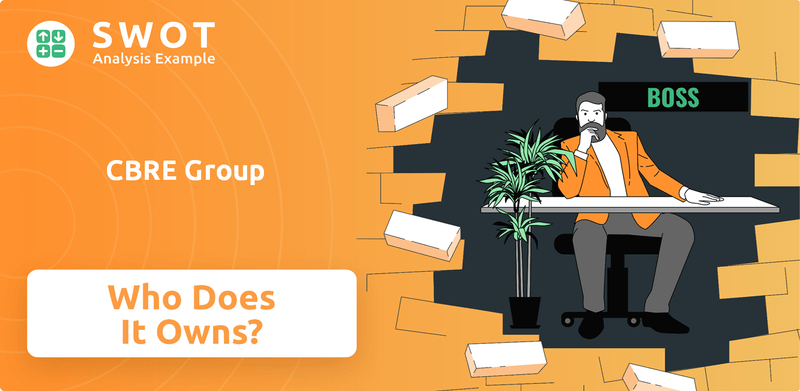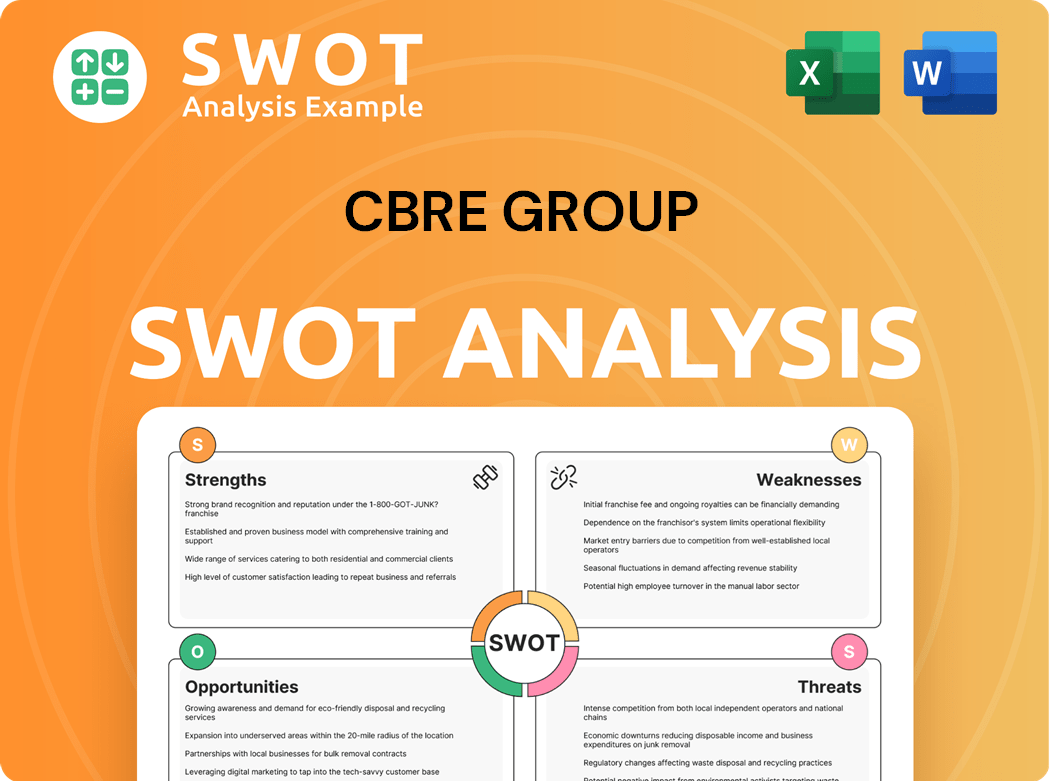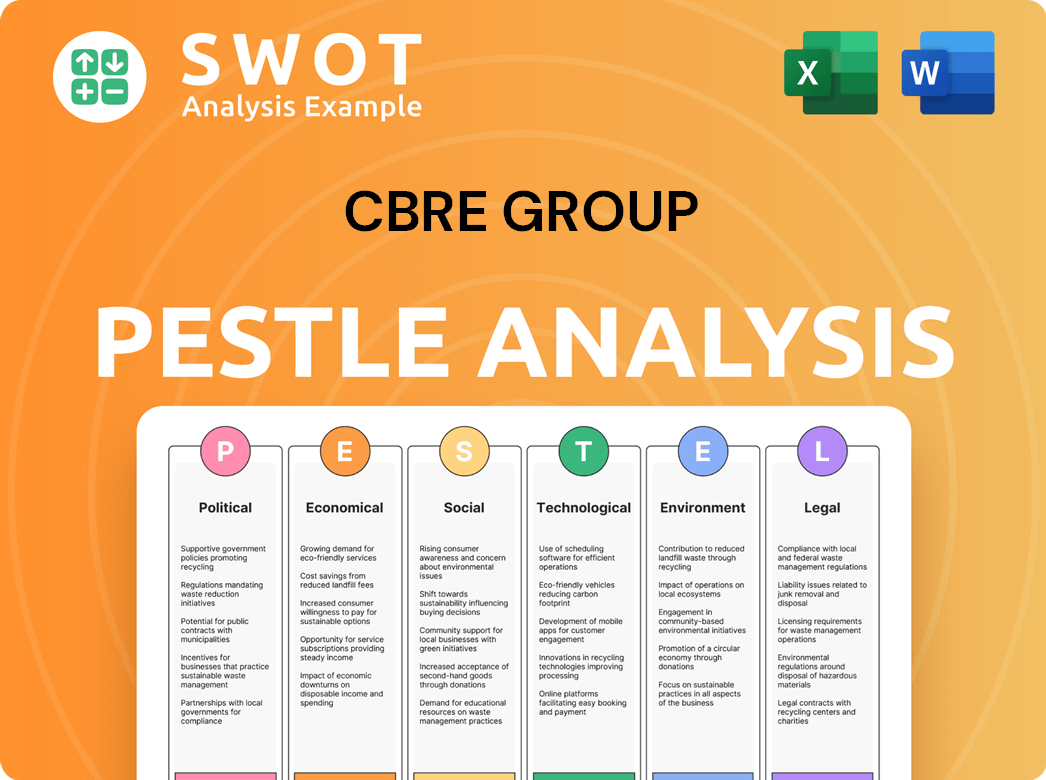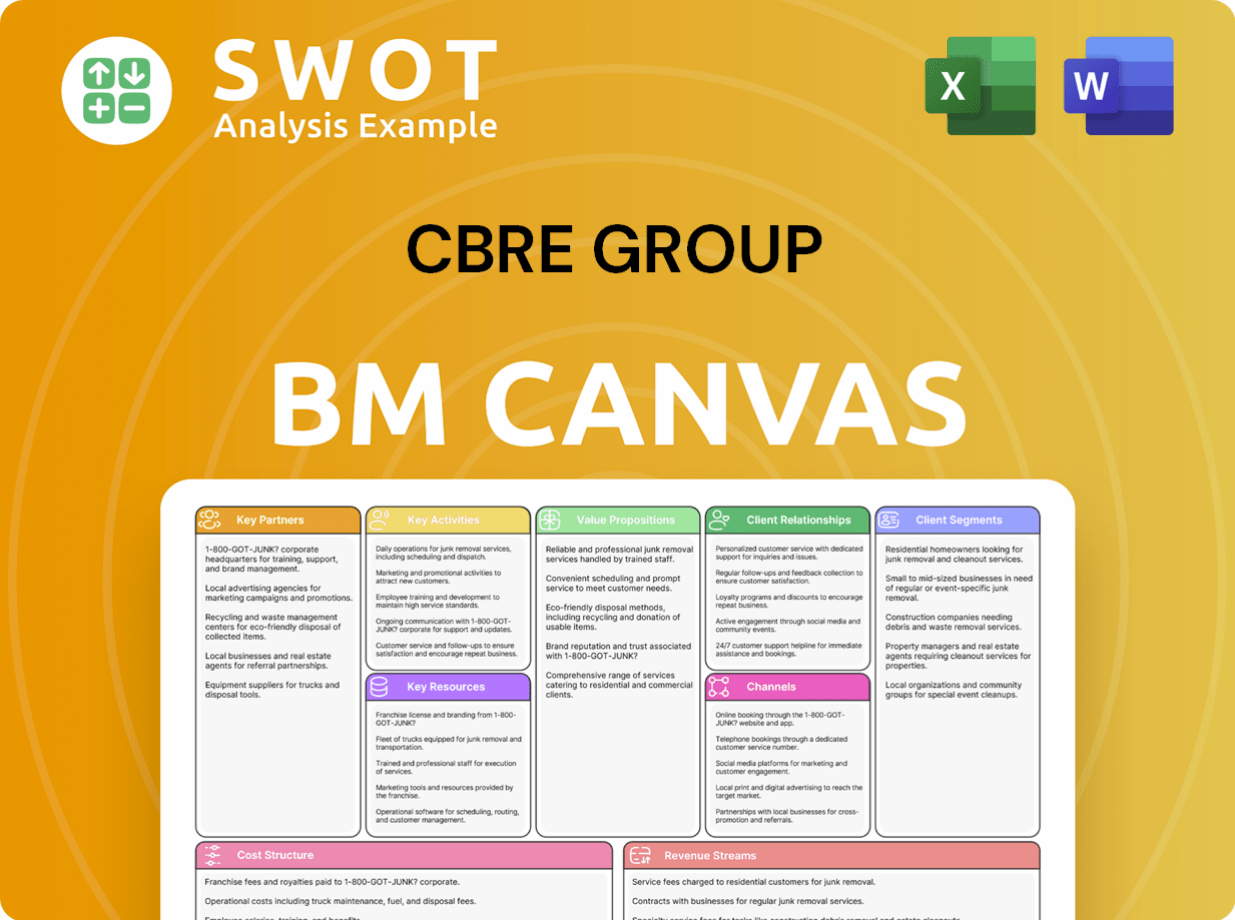CBRE Group Bundle
Who Really Controls CBRE Group?
Understanding the CBRE Group SWOT Analysis is key to grasping its market position. The story of CBRE's ownership is a dynamic one, shaped by pivotal moments like its 2001 leveraged buyout. This journey, from its roots in 1906 to its current status, reveals crucial insights into its strategic direction and financial performance.

This deep dive into CBRE ownership will explore the evolution of CBRE Group owner structure, from its founding to its current status as a global leader in commercial CBRE real estate services. We'll uncover the influence of major investors, the role of public shareholders, and the impact of key decisions on the CBRE company. Knowing Who owns CBRE is essential for anyone looking to understand its long-term strategy and potential for growth, including details about CBRE Group shareholders and CBRE Group stock ownership.
Who Founded CBRE Group?
The story of what is now known as CBRE Group, Inc. began in 1906, when Tucker, Lynch & Coldwell was founded in San Francisco. The firm's early focus was on integrity and client service, as emphasized by Colbert Coldwell, one of the founders. Arthur Banker later joined the team, reinforcing these core values.
The company went through several name changes in its early years, reflecting the evolving partnerships. These changes included Coldwell, Kern & Banker in 1918, Coldwell, Kern, Cornwall & Banker in 1919, and Coldwell, Cornwall & Banker in 1920. After Cornwall's retirement in 1940, the company became Coldwell, Banker & Company, and later, Coldwell Banker in 1974.
A significant shift in ownership occurred in 1981 when Sears acquired Coldwell Banker. The commercial real estate operations were spun off in 1989 through a management-led buyout, which included The Carlyle Group, for roughly $300 million. This move created CB Commercial Real Estate Group Inc. as a privately held entity, while the residential business continued under the Coldwell Banker name.
The company's roots trace back to 1906 with the establishment of Tucker, Lynch & Coldwell in San Francisco.
Colbert Coldwell emphasized integrity, ethics, and a client-centric approach from the start.
The company went through several name changes, reflecting partnerships and evolution, before becoming Coldwell Banker.
In 1981, Sears acquired Coldwell Banker, marking a significant ownership change.
The commercial unit was spun off in 1989 through a management-led buyout, including The Carlyle Group.
This buyout led to the creation of CB Commercial Real Estate Group Inc., a privately held entity.
Understanding the early ownership of CBRE Group, including the transition from its founding to the management buyout, provides insight into the company's evolution. The focus on commercial real estate became more defined after the split from Sears, setting the stage for the company's future growth. This history is crucial when considering the Target Market of CBRE Group, as it reflects the company's strategic shifts and its ability to adapt to market changes. Key moments include the 1981 acquisition by Sears and the 1989 management-led buyout, which reshaped the company's structure.
- The initial focus was on building a foundation of integrity and client service.
- The management buyout in 1989 was a pivotal move, shifting control to a group focused specifically on commercial real estate.
- The Carlyle Group's involvement in the buyout highlights the role of private equity in the company's early development.
- This restructuring allowed for a more focused approach to the commercial real estate market.
CBRE Group SWOT Analysis
- Complete SWOT Breakdown
- Fully Customizable
- Editable in Excel & Word
- Professional Formatting
- Investor-Ready Format

How Has CBRE Group’s Ownership Changed Over Time?
The journey of CBRE Group, Inc. through various ownership structures began with its spin-off from Sears. The company went public in 1996 via an initial public offering (IPO), which raised approximately $80 million. This IPO was a pivotal moment, allowing public shareholders to invest in the company. Later, in 1998, CB Commercial merged with Richard Ellis International, leading to the rebranding as CB Richard Ellis (CBRE).
A significant change occurred in 2001 when an investment group led by Blum Capital acquired CBRE in a leveraged buyout for $800 million, taking the company private. CBRE later re-entered the public markets and is currently listed on the NYSE under the ticker CBRE, as a component of the S&P 500. Understanding the Growth Strategy of CBRE Group provides further insights into its evolution.
| Event | Year | Impact on Ownership |
|---|---|---|
| Spin-off from Sears | Early Days | Established CB Commercial Real Estate Group Inc. |
| Initial Public Offering (IPO) | 1996 | Public shareholders acquired stakes, raised ~$80 million |
| Merger with Richard Ellis International | 1998 | Rebranding to CB Richard Ellis (CBRE) |
| Leveraged Buyout | 2001 | Taken private by Blum Capital for $800 million |
| Re-entry to Public Markets | Ongoing | Listed on NYSE (CBRE), component of S&P 500 |
As of March 24, 2025, The Vanguard Group held a substantial position, owning 47,591,006 shares, which is 15.9% of the outstanding common stock, making them a major shareholder. BlackRock, Inc. also held a significant stake with 28,009,132 shares, accounting for 9.3%. Other major institutional shareholders include State Street Corp, Vanguard Real Estate Index Fund Investor Shares (VGSIX), Harris Associates L P, Vanguard Total Stock Market Index Fund Investor Shares (VTSMX), Vanguard 500 Index Fund Investor Shares (VFINX), Geode Capital Management, Llc, Principal Financial Group Inc, and Fmr Llc. These institutional investors collectively held 352,179,420 shares as of June 12, 2025. The high institutional ownership, which was 98.06% in May 2025, indicates a broad distribution among large investment funds and asset managers. This reflects the company's appeal to large-scale investors and influences its strategy towards sustained performance and shareholder value.
CBRE's ownership has evolved significantly since its IPO.
- The Vanguard Group and BlackRock, Inc. are major institutional shareholders.
- High institutional ownership indicates strong investor confidence.
- CBRE is a publicly traded company on the NYSE.
- Understanding the ownership structure is key to assessing the company's stability and strategy.
CBRE Group PESTLE Analysis
- Covers All 6 PESTLE Categories
- No Research Needed – Save Hours of Work
- Built by Experts, Trusted by Consultants
- Instant Download, Ready to Use
- 100% Editable, Fully Customizable

Who Sits on CBRE Group’s Board?
The current CBRE Group board of directors is pivotal in guiding the company's strategy and representing shareholder interests. The board includes a blend of independent directors and executives. Robert E. Sulentic holds the roles of Chairman, President, and Chief Executive Officer, indicating a unified leadership approach. Key executives on the board include Daniel G. Queenan, CEO of Trammell Crow Company, and Emma E. Giamartino, Chief Financial Officer. This structure aims to balance internal expertise with external oversight, ensuring comprehensive governance. Understanding the CBRE Group owner is crucial for investors and stakeholders alike.
Independent directors such as Ms. Shira D. Goodman, who serves as Lead Independent Director, alongside Mr. Gerardo I. Lopez, Mr. Sanjiv Yajnik, Mr. Brandon B. Boze, Ms. Beth F. Cobert, Mr. Reginald H. Gilyard, Ms. Gunjan Tilak Raj Soni, and Mr. Guy A. Metcalfe, bring external perspectives to the board. Vincent Clancy also joined the board in January 2025. This diverse composition supports effective oversight and strategic decision-making. Knowing who owns CBRE is essential for understanding its corporate structure.
| Board Member | Title | Affiliation |
|---|---|---|
| Robert E. Sulentic | Chairman of the Board, President, and CEO | CBRE Group, Inc. |
| Daniel G. Queenan | CEO | Trammell Crow Company (a subsidiary) |
| Emma E. Giamartino | Chief Financial Officer | CBRE Group, Inc. |
| Shira D. Goodman | Lead Independent Director | Independent |
| Gerardo I. Lopez | Director | Independent |
| Sanjiv Yajnik | Director | Independent |
| Brandon B. Boze | Director | Independent |
| Beth F. Cobert | Director | Independent |
| Reginald H. Gilyard | Director | Independent |
| Gunjan Tilak Raj Soni | Director | Independent |
| Guy A. Metcalfe | Director | Independent |
| Vincent Clancy | Director | Independent |
CBRE's voting structure generally operates on a one-share-one-vote basis. The annual meeting of stockholders for 2025 was held virtually on May 21, 2025. Shareholders could vote electronically and submit questions. Proposals typically include electing board-nominated directors, ratifying the independent registered public accounting firm, and advisory votes on executive compensation. Significant institutional shareholders, such as The Vanguard Group and BlackRock, Inc., holding 15.9% and 9.3% respectively as of March 24, 2025, have substantial voting power. In March 2025, CBRE amended its bylaws to eliminate director term limits, allowing for potentially longer tenures for experienced board members, which impacts CBRE Group shareholders.
The board of directors includes a mix of executives and independent members, ensuring diverse perspectives.
- Robert E. Sulentic serves as Chairman, President, and CEO.
- The voting structure is one-share-one-vote.
- Major institutional shareholders hold significant voting power.
- Term limits for directors were eliminated in March 2025.
CBRE Group Business Model Canvas
- Complete 9-Block Business Model Canvas
- Effortlessly Communicate Your Business Strategy
- Investor-Ready BMC Format
- 100% Editable and Customizable
- Clear and Structured Layout

What Recent Changes Have Shaped CBRE Group’s Ownership Landscape?
Over the past few years, the ownership structure of CBRE Group, a leading real estate services and investment firm, has undergone notable shifts. A significant trend has been the company's active share repurchase program, reflecting a commitment to returning capital to shareholders. For instance, as of April 23, 2025, CBRE had repurchased approximately 4.6 million shares for $585 million since the end of 2024, with approximately $5.2 billion remaining under its authorized stock repurchase program. In 2024 alone, the company bought back 5,110,624 shares of its Class A common stock for $644 million, and in the first quarter of 2025, share buybacks totaled $418 million.
In addition to share repurchases, CBRE has been strategically involved in mergers and acquisitions. An example of this is the June 2024 announcement to merge its project management businesses into Turner & Townsend, increasing its ownership stake to 70%. Furthermore, in January 2025, CBRE acquired full ownership of Industrious National Management Company LLC, a flexible workplace solutions provider. These moves demonstrate CBRE's efforts to expand its service offerings and market presence. For more information on the company's revenue model, explore Revenue Streams & Business Model of CBRE Group.
| Metric | Details | Date |
|---|---|---|
| Share Repurchases (Since Year-End 2024) | Approximately 4.6 million shares for $585 million | April 23, 2025 |
| Remaining Capacity Under Stock Repurchase Program | Approximately $5.2 billion | April 23, 2025 |
| Institutional Ownership | 98.06% | May 2025 |
Leadership changes and industry trends also influence CBRE's ownership profile. In April 2024, Vikram Kohli assumed direct oversight of Advisory Services and Global Workplace Solutions (GWS). In December 2024, Adam Gallistel and Andy Glanzman were appointed Co-CEOs of CBRE Investment Management, with Gallistel joining in April 2025. Institutional investors held a substantial 98.06% of the shares as of May 2025, with insiders holding 0.55%. Major institutional holders include Vanguard Group Inc, BlackRock, Inc., and State Street Corp. CBRE anticipates revenue increases of 9.4% in 2025 and 8.8% in 2026, reflecting its strategic focus on diversification and growth.
CBRE Group is a publicly traded company, with a significant portion of its shares held by institutional investors. Major institutional holders include Vanguard Group Inc, BlackRock, Inc., and State Street Corp.
CBRE has been actively repurchasing its shares, indicating a commitment to returning capital to shareholders. Strategic acquisitions and leadership changes also shape its ownership profile.
As of May 2025, institutional investors held a substantial portion of CBRE shares, with insiders holding a smaller percentage. This indicates strong confidence from major investment funds.
Yes, CBRE Group is a publicly traded company. This structure allows for institutional investment and public access to its stock.
CBRE Group Porter's Five Forces Analysis
- Covers All 5 Competitive Forces in Detail
- Structured for Consultants, Students, and Founders
- 100% Editable in Microsoft Word & Excel
- Instant Digital Download – Use Immediately
- Compatible with Mac & PC – Fully Unlocked

Related Blogs
- What are Mission Vision & Core Values of CBRE Group Company?
- What is Competitive Landscape of CBRE Group Company?
- What is Growth Strategy and Future Prospects of CBRE Group Company?
- How Does CBRE Group Company Work?
- What is Sales and Marketing Strategy of CBRE Group Company?
- What is Brief History of CBRE Group Company?
- What is Customer Demographics and Target Market of CBRE Group Company?
Disclaimer
All information, articles, and product details provided on this website are for general informational and educational purposes only. We do not claim any ownership over, nor do we intend to infringe upon, any trademarks, copyrights, logos, brand names, or other intellectual property mentioned or depicted on this site. Such intellectual property remains the property of its respective owners, and any references here are made solely for identification or informational purposes, without implying any affiliation, endorsement, or partnership.
We make no representations or warranties, express or implied, regarding the accuracy, completeness, or suitability of any content or products presented. Nothing on this website should be construed as legal, tax, investment, financial, medical, or other professional advice. In addition, no part of this site—including articles or product references—constitutes a solicitation, recommendation, endorsement, advertisement, or offer to buy or sell any securities, franchises, or other financial instruments, particularly in jurisdictions where such activity would be unlawful.
All content is of a general nature and may not address the specific circumstances of any individual or entity. It is not a substitute for professional advice or services. Any actions you take based on the information provided here are strictly at your own risk. You accept full responsibility for any decisions or outcomes arising from your use of this website and agree to release us from any liability in connection with your use of, or reliance upon, the content or products found herein.